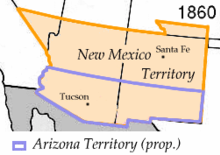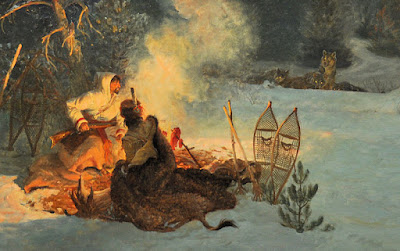In 1540, Commander Francisco Vásquez de Coronado was chasing his dreams across what is now the American Southwest. Specifically, he was dreaming of Seven Cities of Gold and the land he was searching in was too big for him to do all the looking himself. So he sent out a party of about a dozen of his underlings along with a couple of Hopi guides to explore off to the west. These lucky soldados
 |
| An impassible barrier |
were the first Europeans to stumble across what we now know as the Grand Canyon. Of course, they didn't see it that way. To them it was a Grand Pain in the Trasero with no easy way to get past it and no golden cities in site. They sent a few of the nimblest in their party to try and climb down to the river but to no avail, so they went back and told Coronado there was nothing worthwhile in the area and went to look elsewhere. The sight of the canyon so impressed the Spaniards that no one went back to take a second look for over 200 yrs.
Today we see things a little differently and the Grand Canyon is one of the most popular tourist attractions in the world. We did not actually stay in the Grand Canyon, but camped instead in Williams, "The Gateway to the Grand Canyon" and took the train. We had done this before, about 5 or 6 years ago, but it was a fun enough day that we decided to do it again. After all, it's only money.
 |
| A disagreement over breakfast |
 |
| Dispute resolved |
While they waited for their passengers to gather, a group of local cowboy neer-do-wells got into a shoot-out over where they were gonna get breakfast and had to be pacified by the town sheriff. Nothing like a little gun play in the mornin'. One drawback of black powder however, is that it blows out a sizable quantity of smoke that shows exactly where the gun was pointed when fired and this was generally nowhere near where the shot supposedly hit. Oh well, at least it was appropriately loud.
 |
| The train goes around a bend |
After they had finished shooting each other, we piled onto the train and headed out. It is about a 90 minute trip each way between Williams and the canyon. They last time we went much of this was a uniform brown, but with the wet winter we just had, the landscape was varying shades of green and generally much more scenic this time around. When we reached the Grand Canyon Village we hopped onto a bus and took a tour of the west side of the south rim. The air was not perfectly clear, but was a lot better than the last couple of times we were there so the viewing was pretty good. See photos.

 |
| The Colorado River a mile below us |
 |
| It just goes on forever |
 |
| The El Tovar Hotel |
When the bus tour ended, we barely had time to have lunch at the El Tovar hotel before train departure. We love the Tovar. On our last visit I mostly just sat out on their porch and gazed out over the south rim. The hotel was built in 1905, predating the National Park itself by 11 years and was originally a Harvey House, that great hotel chain operated in conjunction with the Santa Fe Railroad in the days before auto travel redefined America. It was an early example of American "National Park Rustic" architecture and has been well maintained over the years. However, with a motorhome parked in Williams, we did not opt to spend the $263 to stay the night.
On the way back we had a modicum of excitement. Thirty minutes into the trip, one of our pair of diesel engines blew up and had to be shut down. We stopped for about a half hour while they figured things out. It is mostly downhill from the south rim to Williams so the remaining engine was able to get us moving again, mostly coasting. Meanwhile, they sent another diesel from the roundhouse to meet us. About 20 minutes from the station they stopped to hook this onto the train to help haul us the last uphill portion back to town. At about this time the same cowboys we had seen in the morning, some of whom were supposedly shot dead, decided to rob the train. We were terrified. Fortunately the sheriff showed up to haul them all off to the hoosegow. We were glad that justice had been served, but I was mostly glad I didn't have to walk 40 miles back to town.
 |
| Second trip to the canyon by car |
A couple of days later we returned to the south rim, this time traveling by car, to try and get some evening pictures of the area east of the hotel. While there I hopped along a trail pretending to be a young man and managed to fall on my face. I really shouldn't do that anymore. No major damage but getting back on my feet was embarrassingly difficult and there was a large audience. The scrapes and bruises will eventually go away but my shirt was not salvageable. On the way out of the park we passed a herd of elk grazing contentedly by the roadside, paying no mind to the passing cars and hikers. Do you suppose they know they can't be shot there?

While we were in Williams, Vicki had to send some hard copy paperwork back to the home office in Riverside (don't ask me why) and FedEx is not a thing to be found in Williams, so we drove the 30 miles east into Flagstaff. While there we stopped to visit the Museum of Northern Arizona, not realizing we had been there before some years ago. It is a nice facility, but this time around about a third of the space was closed down, presumably for updating or maintenance or something. The pride of the hall is the skeleton of a locally discovered dinosaur, Nothronychus graffami, a member of a dinosaur group previously known only from China. This animal is related to T. Rex but based on it's teeth, had evolved into a plant eater. It retained, however, a set of enormous claws on the end of each upper limb. Strange critter to look at.

The museum also has fairly extensive collections of Indian pottery and jewelry and was showing a traveling exhibit of area quadrupeds from the National Geographic Society. It serves as a pretty good introduction to the Colorado Plateau if anyone is interested.
As far as entertainment in Williams, unless you really enjoy watching cowboys pretend to shoot each other, the pickings are pretty slim. There is a gas station museum where you can look at a couple of old cars and some old style gas pumps and that's about it. The town does have a large assortment of restaurants of varying quality but if you are ever in the area, do not miss the chance to dine at the Red Raven. This is an upscale eatery that we had sampled on a previous trip and were eager to return to. This time around I had duck, which was delicious, and Vicki got a lamb kabob. Somewhat more expensive than the Pine County Restaurant up the street, but definitely worth it.
 |
| Duck at the Red Raven... yum. |
Bonus Pics

 |
| Grand Canyon Railway in flight entertainment |
 |
| Another view into the abyss |
 |
| Schnoodles visit the canyon |
 |
| The Gas Station Museum |
 |
| Museum of Northern Arizona in Flagstaff |
 |
| Hopi Jewelry |





















































